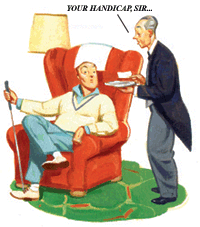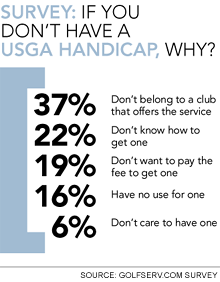|
How to detect a sandbagger or a vanity handicapper
By Dean Knuth
Golf Digest
August 2003
 A Golf Digest Campaign: Get a Handicap
A Golf Digest Campaign: Get a Handicap
Why is it that we so rarely play to our single-digit handicaps or that some
of those 14-handicappers often play a lot better than we think they should? We
asked Contributing Editor and golf handicap expert Dean Knuth for some
explanations and mathematical possibilities when it comes to playing to "your
number."
Q: How often should I play to -- or beat -- my handicap?
Knuth: If
it's accurate, you should average about three shots above your handicap. For
example, a player with a course handicap of 16 on a course with a rating of 71.1
should score on average about 90. The USGA handicap system is based on 96
percent of the best 10 of a golfer's last 20 rounds, not simply average
score.
 Scores normally fit into the classic bell-shaped curve.
More than half of your scores should be within three strokes of three over your
handicap. In other words, taking our 16-handicapper, more than half of the
rounds should be between 87 and 93. The player will better the handicap --
shooting 87 or lower -- only about 20 percent of the time, or once every five
rounds. Golfers should only beat their handicap by three strokes one out of
every 20 rounds. Scores normally fit into the classic bell-shaped curve.
More than half of your scores should be within three strokes of three over your
handicap. In other words, taking our 16-handicapper, more than half of the
rounds should be between 87 and 93. The player will better the handicap --
shooting 87 or lower -- only about 20 percent of the time, or once every five
rounds. Golfers should only beat their handicap by three strokes one out of
every 20 rounds.
Q: What are the odds of that 16-handicapper breaking 80?
Knuth:
The odds of someone beating their handicap -- if it's an honest handicap -- by
eight strokes are 1,138 to 1. For most players that represents about 54 years of
golf -- a lifetime for many. The odds of beating your number by eight strokes
twice are 14,912 to 1, or 710 years of golf.
Q: Are
there more sandbaggers s(people who maintain artificially high handicaps so they
can win net competitions) or vanity handicappers (people who think they're a lot
better than they really are and whose handicaps are lower than they should
be)?
Knuth: About 1 to 2 percent of golfers are sandbaggers,
and about 10 percent fall into the vanity-handicap category (also called
"reverse sandbaggers"). Sandbaggers typically post very few scores -- only their
worst rounds -- or add strokes to their score or intentionally play a few bad
holes near the end of a round. They usually play better than their handicaps in
tournaments. Vanity handicappers, on the other hand, typically post only their
best scores, or scores better than what they actually shot.
Of these two,
the sandbagger is the more reprehensible, because that player is manipulating
the system for personal gain. Vanity handicappers are just delusional optimists,
though they are terrible partners to be stuck with.
 Q: How can you spot a vanity
handicapper? Q: How can you spot a vanity
handicapper?
Knuth: Vanity handicappers are constantly apologizing for
"unusually" bad play. It starts on the first tee, how they're just not playing
well right now, or how they have some new equipment that they haven't gotten
used to, or how they're in the middle of a swing change. For men, the reverse
sandbagger typically carries a single-digit handicap but plays to a
15.
Q: Are
handicap inaccuracies as common among women golfers as they are among
men?
Knuth: It's hard to generalize, but during the 16 years that I was
at the USGA, and having met with hundreds of regional and state men's and
women's golf associations, it's widely accepted that the vanity handicap is more
prevalent in women's golf. The reason is that women's teams often set a maximum
handicap such as 14 or 18, which is relatively low for women. The average
women's handicap hovers at 31, compared to 16 for men. A small percentage of
women are single-digit handicappers, primarily because many courses are set up
to play too long from the women's tees.
|




